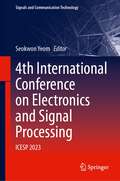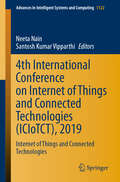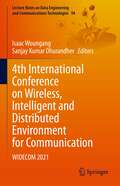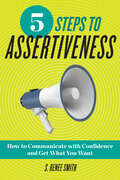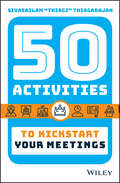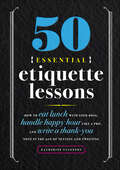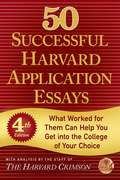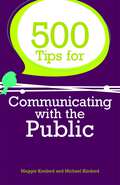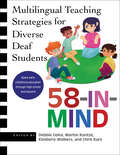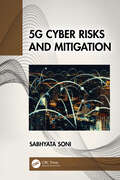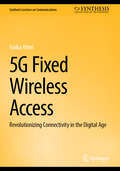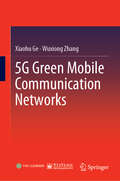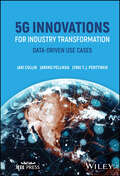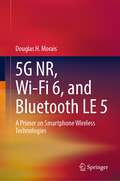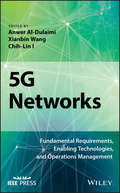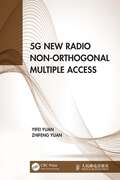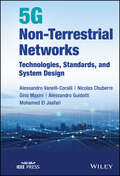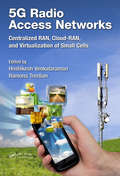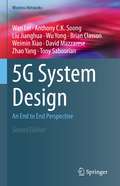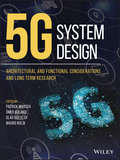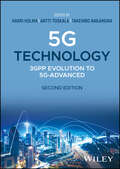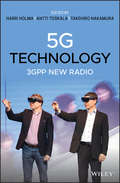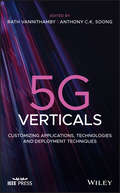- Table View
- List View
4th International Conference on Electronics and Signal Processing: ICESP 2023 (Signals and Communication Technology)
by Seokwon YeomThis book presents the proceedings of the 4th International Conference on Electronics and Signal Processing (ICESP 2023), which was held in Macau, China during January 13-15, 2023. The book consists of contributions from various authors from both academia and industry, focusing on a diverse aspect of signal processing and information communication systems. The published papers suggest cutting-edge solutions that contribute to the quest for the future applications and communicating systems. The book is a useful reference to research students, research fellows, and scientists and engineers in the corresponding fields.
4th International Conference on Internet of Things and Connected Technologies: Internet of Things and Connected Technologies (Advances in Intelligent Systems and Computing #1122)
by Neeta Nain Santosh Kumar VipparthiThis book presents the proceedings of the 4th International Conference on Internet of Things and Connected Technologies (ICIoTCT), held on May 9–10, 2019, at Malaviya National Institute of Technology (MNIT), Jaipur, India. The Internet of Things (IoT) promises to usher in a revolutionary, fully interconnected “smart” world, with relationships between objects and their environment and objects and people becoming more tightly intertwined. The prospect of the Internet of Things as a ubiquitous array of devices bound to the Internet could fundamentally change how people think about what it means to be “online”. The ICIotCT 2019 conference provided a platform to discuss advances in Internet of Things (IoT) and connected technologies, such as various protocols and standards. It also offered participants the opportunity to interact with experts through keynote talks, paper presentations and discussions, and as such stimulated research. With the recent adoption of a variety of enabling wireless communication technologies, like RFID tags, BLE, ZigBee, embedded sensor and actuator nodes, and various protocols such as CoAP, MQTT and DNS, IoT has moved on from its infancy. Today smart sensors can collaborate directly with machines to automate decision-making or to control a task without human involvement. Further, smart technologies, including green electronics, green radios, fuzzy neural approaches, and intelligent signal processing techniques play an important role in the development of the wearable healthcare devices.
4th International Conference on Wireless, Intelligent and Distributed Environment for Communication: WIDECOM 2021 (Lecture Notes on Data Engineering and Communications Technologies #94)
by Isaac Woungang Sanjay Kumar DhurandherThis book presents the proceedings of the 4th International Conference on Wireless Intelligent and Distributed Environment for Communication (WIDECOM 2021), which took place at University of KwaZulu-Natal, South Africa, October 13-15, 2021. The book addresses issues related to new dependability paradigms, design, and performance of dependable network computing and mobile systems, as well as issues related to the security of these systems. The main tracks include infrastructure, architecture, algorithms, and protocols. The goal of the conference is to provide a forum for researchers, students, scientists and engineers working in academia and industry to share their experiences, new ideas and research results in the above-mentioned areas.
5 Steps to Assertiveness: How to Communicate with Confidence and Get What You Want
by S. Renee Smith5 Steps to Assertiveness is the modern how-to guide to communicate with assertiveness and build stronger relationships in today's world. Assertiveness goes beyond standing up for yourself. Assertiveness is saying what you want in a way that makes others want to listen. This philosophy is at the heart of the self-development method created by nationally recognized self-esteem and communication expert S. Renee Smith. In 5 Steps to Assertiveness, the nationally recognized self-esteem and communication expert distills what she's learned and taught about assertiveness over the past 20 years into 5 easy-to-follow steps. Built on her successful engagement with hundreds of organizations and individual clients, S. Renee has curated this actionable 5-step how-to guide that will help you see the value of what you have to say— and gain the confidence to say it. 5 Steps to Assertiveness is the most current guide to persuasive communication, and includes: A 5-step assertiveness action plan to help you understand your communication style and identify changes you can make that will lead to greater assertiveness An overview of the 4 different communication styles and the benefits and challenges of changing yours Practical exercises and examples that lead to real-world assertiveness in personal and professional situations When you communicate with assertiveness, you control where you go, how far you go, and the shape you're in when you get there. With 5 Steps to Assertiveness, the power is in your hands.
50 Activities to Kickstart Your Meetings
by Sivasailam ThiagarajanInfuse creativity, collaboration, and optimism into every meeting Dr. Sivasailam "Thiagi" Thiagarajan is an internationally recognized expert in effective group communication. He is known for engaging diverse participants at some of the world's leading organizations. In 50 Activities to Kickstart Your Meetings, Thiagi reveals his most effective "Group Performance Support" tools—tried and tested activities that will get your meeting participants thinking, talking, and collaborating like never before. We aren't born knowing how to lead and participate effectively in meetings. Our meeting participants want to engage and generate results just as much as we do—but first we need to teach them how. This book's enjoyable activities will help people reach their collaborative potential, and they'll have fun doing it! Whether you are facilitating meetings with 2 people or 200 people (or more!), and whether you have 2 minutes or 2 hours to fill, this book has an activity to fit. Get your participants engaged and turn them into active stakeholders in all aspects of the meeting process—from morale building and inclusivity to more productive discussions and creative collaboration, 50 Activities to Kickstart Your Meetings covers it all. An indispensable resource for anyone who wants to transform meetings into engines of creativity and growth!
50 Essential Etiquette Lessons: How to Eat Lunch with Your Boss, Handle Happy Hour Like a Pro, and Write a Thank You Note in the Age of Texting and Tweeting
by Katherine FurmanStay cool in any situation with this modern manners guide.Meeting strangers at a party, alone in the elevator with the CEO, declining a second date because the first was a disaster—social situations apply a lot of pressure to do and say the right thing. 50 Essential Etiquette Lessons shows you the best way to approach these common challenges with confidence and ease. Never mind putting your pinkies up when you drink tea—this guide is packed with modern examples of how to handle any sticky situation.Short, easy lessons cover workplace etiquette, to help you come across as an on-point, put-together asset to any company. Learn specific strategies for performing your best in social settings, both in person and online. Master skills like keeping conversation going, showing your best side on social media, giving gifts appropriately, and more.50 Essential Etiquette Lessons includes:50 indispensable tips—Get etiquette advice for dining out with friends, navigating a networking event, celebrating special occasions, and more.Updated manners—No need to be fussy or formal—this is practical, straightforward etiquette for today.Real-life examples—Tackle tricky scenarios with the help of a Q&A chapter that shows you how to use etiquette confidently every day.With 50 Essential Etiquette Lessons, embarrassing missteps and awkward silences will be a thing of the past.
50 Successful Harvard Application Essays Fourth Edition
by The Staff of The Harvard CrimsonThis book gives you the most inspiring approaches, both conventional and creative, that won over admissions officers at Harvard University, one of the nation's top ranked colleges.
500 Tips for Communicating with the Public
by Maggie Kindred Michael KindredThis is a light-hearted, easily digestible guide with a wealth of handy hints and tips for communicating with the public. For those in the helping professions, communicating with the public can sometimes be a challenge, and different skills are needed to those used when communicating with friends and family. This book addresses these issues by providing hundreds of tips on how to communicate with the public, covering topics such as managing conflict, assertiveness, feelings, listening and boundaries. It also includes guidance on reflection, supervision, confidentiality and anti-discrimination. The book uses a fun and accessible approach, making the advice easy to read and then put into practice. This handy guide will be invaluable to a range of practitioners in the helping professions including health visitors, social care workers, probation officers and teachers, as well as any other professional looking for tips on how to communicate effectively.
58-IN-MIND: Multilingual Teaching Strategies for Diverse Deaf Students
by Debbie Golos; Marlon Kuntze; Kimberly Wolbers; Chris KurzA highly practical and engaging resource for current and future teachers, 58-IN-MIND describes and demonstrates theoretically-driven, research-based, and classroom-tested best practices for using American Sign Language and English in instruction across the curriculum. The multilingual and multimodal instructional strategies presented here are embedded in approaches that aid learning and foster well-being. This book will support teachers in creating meaningful educational experiences for Deaf students in all grades, from early childhood education through high school. Each chapter is written by a team of researchers and P–12 teachers with at least one Deaf coauthor. With seventy-five percent of the authors being Deaf, this is the first teaching methods book to harness the expertise of Deaf professionals at this level, highlighting their vital role in Deaf education and in shaping inclusive and effective learning environments. This book meets the need for a resource that recognizes the diversity of Deaf students by creating space in the classroom to honor their home/heritage languages, cultures, races, genders, abilities, hearing levels, and other multiple and intersecting identities. Written in a conversational tone, the book includes core recommendations for instruction of the targeted subject area, examples of key strategies, lessons and real stories from those working in the field, suggestions for practice, and recommended resources. “58-IN-MIND” in the title refers to the version of the ASL sign "stick" that is made on the forehead, which is equivalent to the English idiom “to stick in one's mind.” As in, when students learn in a culturally responsive manner, the learning is likely to stick. The title also alludes indirectly to the collective aspirations of the chapter authors that the practices discussed in the book will also stick in the readers’ minds, and thus have a transformative impact on the way Deaf students are taught.
5G Cyber Risks and Mitigation
by Sabhyata Soni5 G technology is the next step in the evolution of wireless communication. It offers faster speeds and more bandwidth than 4G. One of the biggest differences between 4G and 5G is that 5G will be used for a wider range of applications. This makes it ideal for applications such as autonomous vehicles, smart cities, and the internet of things. This means that there will be more devices connected to 5G networks, making them more vulnerable to cyber attacks. However, 5 G also introduces new cyber risks that need to be addressed. In addition, 5 G networks are expected to be much more complex, making them harder to secure. 5G networks will use new technologies that could make them more vulnerable to attack. These technologies include massive MIMO (multiple input, multiple output), which uses more antennas than traditional cellular networks, and millimeter wave (mmWave), which uses higher frequencies than traditional cellular networks. These new technologies could make it easier for attackers to intercept data or disrupt service. To address these concerns, security measures must be implemented throughout the network. Security mechanisms must be included in the design of 5G networks and must be updated as new threats are identified. Moreover, to address these risks, 5 G security standards need to be developed and implemented. These standards should include measures to protect against Denial of Service (DoS) attacks, malware infections, and other threats. Fortunately, artificial intelligence can play a key role in mitigating these risks. With so many interconnected devices, it can be difficult to identify and isolate malicious traffic. AI can help by identifying patterns in data that would otherwise be undetectable to humans. 6G technology is still in the early developmental stages, but security experts are already voicing concerns about the potential challenges that could arise with this next generation of mobile connectivity. Experts are already working on a roadmap for 6G deployment, and they are confident that these and other challenges can be overcome.
5G Fixed Wireless Access: Revolutionizing Connectivity in the Digital Age (Synthesis Lectures on Communications)
by Isiaka AlimiThis book explores the transformative potential of 5G technology in delivering high-speed broadband services through wireless means, particularly targeting underserved and rural areas. The book covers several key topics, including high-frequency spectrum bands, advanced transmission schemes, multi-connectivity, adaptive numerology, and Integrated Access and Backhaul (IAB). These elements are critical for enhancing network performance, increasing capacity, and reducing latency. High-frequency spectrum bands, such as those above 24 GHz, are essential for providing the necessary bandwidth to support high data rates and capacity. The book explains how these bands, while offering unprecedented peak rates, present challenges such as limited coverage and penetration, which are addressed through advanced technical solutions. Advanced transmission schemes, including massive beamforming and Multiple-Input Multiple-Output, are explored in detail. These technologies enable the efficient use of the spectrum by allowing multiple user terminals to be served simultaneously on the same frequency resources, thereby increasing the overall network capacity and improving user experiences. Multi-connectivity and adaptive numerology are also key topics. Multi-connectivity allows user equipment to connect to multiple network nodes simultaneously, improving reliability and performance. Adaptive numerology, defined in 3GPP Release 15, supports a flexible range of subcarrier spacing to cater to different services, quality of service requirements, latency needs, and frequency ranges. IAB is another significant topic covered in the book. IAB leverages the same spectrum for both access and backhaul, simplifying deployment and reducing costs. By using the 5G infrastructure to support backhaul, it eliminates the need for extensive fiber installations, making it easier to extend high-speed connectivity to remote and rural areas. These topics are crucial as they collectively address the limitations of traditional wired infrastructure, which is often costly and time-consuming to deploy in rural and hard-to-reach areas. By leveraging 5G Fixed Wireless Access (FWA), the book sets out to solve the problem of the digital divide, aiming to make high-speed internet more accessible and affordable. The relevance of these solutions is underscored by the growing global demand for reliable, high-speed internet access. As the book outlines, 5G FWA not only enhances broadband services but also plays a pivotal role in bridging the digital divide, ensuring that more people, regardless of their location, can benefit from the advancements in internet technology. This makes "5G FWA " an essential read for understanding the future of broadband connectivity and the strategic approaches needed to overcome deployment challenges. This book is intended to be a definitive guide for professionals, researchers, policymakers, and anyone interested in understanding the nuances and implications of this transformative technology.
5G Green Mobile Communication Networks
by Xiaohu Ge Wuxiong ZhangThis book focuses on the modeling, optimization, and applications of 5G green mobile communication networks, aimed at improving energy efficiency and spectrum utilization in 5G systems. It offers a balance between theoretical analysis and engineering practice, providing in-depth studies of a number of major topics, such as energy consumption models, optimization, system design, implementation, and performance evaluation. It also discusses four aspects of green communication in detail: cellular networks, resource management, wireless transmissions and multi-media communications. Further, this unique book comprehensively and systematically discusses green optimization in wireless mobile communications. As such it is a valuable resource for researchers, engineers, and graduate students in various fields, including telecommunications engineering, electrical and electronic engineering, and computer engineering, particularly those interested in green communications.
5G Innovations for Industry Transformation: Data-driven Use Cases
by Jyrki T. Penttinen Jari Collin Jarkko Pellikka5G INNOVATIONS FOR INDUSTRY TRANSFORMATION Authoritative resource providing insight on real-life industrial 5G use cases in driving customer value, productivity, and sustainability ambitions With 5G innovations rapidly expanding to different areas within technology, 5G Innovations for Industry Transformation provides key information on how 5G technology can positively impact digital transformation in the industry sectors, discussing new data-driven business opportunities, including green digital transition, new standards for sustainability, and real-time data-driven services, introducing case studies that cover a variety of industries, from the oil & gas industry to the telecom industry, along with the lessons learned from these case studies, and providing insights into how 5G technology will transform businesses by sharing real-time customer solutions, fair data sharing principles, and ecosystem and change management. The book summarizes novelty aspects in a compact and practical way to benefit users and specialists in the field who want to understand some of the very key aspects of 5G. To aid in reader comprehension, the book contains tables, figures of technical principles and architectural block diagrams, and photographs further explaining key topics. Sample topics covered in 5G Innovations for Industry Transformation include: 5G SA technology with new capabilities, 5G private networks, and how smart, connected products are transforming competition Implications of 5G applied to your particular business and/or industry, and how to scale up and industrialize based on these implications How to lead the charge in relation to optimizing business practices based on the advent of 5G, and details on navigating the platform economy How 5G affects data privacy and security, and other integrated capabilities of 5G, such as processes, data, technology, and competencies Based on real-world experiences and high-quality research and presenting practical examples that serve as a useful guiding hand, 5G Innovations for Industry Transformation is an essential resource for change leaders, enterprise architects, and software developers of any industrial enterprise seeking to drive digitalization forward in their value chain and organization.
5G NR, Wi-Fi 6, and Bluetooth LE 5: A Primer on Smartphone Wireless Technologies
by Douglas H MoraisThis book provides, at a high level and in a tractable fashion, a description of how wireless communications are achieved in the latest smartphones. The author shows how smartphones communicate via three separate systems, namely 5G NR, Wi-Fi 6, and Bluetooth Low Energy 5. He explains how 5G NR allows mobile voice and high-speed data communication, how Wi-Fi allows smartphone attachment to the Internet independent of 5G NR, and how Bluetooth allows smartphone attachment to speakers, in-car entertainment systems, smart watches, etc. This text explains the key basic technologies employed and then addresses how each system operates. This book is of interest to anyone with a rudimentary scientific understanding who desires to know more at an intuitive level rather than rigorous one how smartphones achieve wireless communications.
5G Networks: Fundamental Requirements, Enabling Technologies, and Operations Management
by Anwer Al-Dulaimi Xianbin Wang Chih-Lin IA reliable and focused treatment of the emergent technology of fifth generation (5G) networks This book provides an understanding of the most recent developments in 5G, from both theoretical and industrial perspectives. It identifies and discusses technical challenges and recent results related to improving capacity and spectral efficiency on the radio interface side, and operations management on the core network side. It covers both existing network technologies and those currently in development in three major areas of 5G: spectrum extension, spatial spectrum utilization, and core network and network topology management. It explores new spectrum opportunities; the capability of radio access technology; and the operation of network infrastructure and heterogeneous QoE provisioning. 5G Networks: Fundamental Requirements, Enabling Technologies, and Operations Management is split into five sections: Physical Layer for 5G Radio Interface Technologies; Radio Access Technology for 5G Networks; 5G Network Interworking and Core Network Advancements; Vertical 5G Applications; and R&D and 5G Standardization. It starts by introducing emerging technologies in 5G software, hardware, and management aspects before moving on to cover waveform design for 5G and beyond; code design for multi-user MIMO; network slicing for 5G networks; machine type communication in the 5G era; provisioning unlicensed LAA interface for smart grid applications; moving toward all-IT 5G end-to-end infrastructure; and more. This valuable resource: Provides a comprehensive reference for all layers of 5G networks Focuses on fundamental issues in an easy language that is understandable by a wide audience Includes both beginner and advanced examples at the end of each section Features sections on major open research challenges 5G Networks: Fundamental Requirements, Enabling Technologies, and Operations Management is an excellent book for graduate students, academic researchers, and industry professionals, involved in 5G technology.
5G New Radio Non-Orthogonal Multiple Access
by Yifei Yuan Zhifeng YuanThis book provides detailed descriptions of downlink non-orthogonal multiple transmissions and uplink non-orthogonal multiple access (NOMA) from the aspects of majorly used 5G new radio scenarios and system performance. For the downlink, the discussion focuses on the candidate schemes in 3GPP standards which are not only applicable to unicast services but also to broadcast/multicast scenarios. For the uplink, the main target scenario is massive machine-type communications where grant-free transmission can reduce signaling overhead, power consumption of devices and access delays. The design principles of several uplink NOMA schemes are discussed in-depth, together with the analysis of their performances and receiver complexities. Devoted to the basic technologies of NOMA and its theoretical principles, data analysis, basic algorithms, evaluation methodology and simulation results, this book will be an essential read for researchers and students of digital communications, wireless communications engineers and those who are interested in mobile communications in general.
5G Non-Terrestrial Networks: Technologies, Standards, and System Design
by Alessandro Vanelli-Coralli Nicolas Chuberre Gino Masini Alessandro Guidotti Mohamed El Jaafari5G Non-Terrestrial Networks Provides a complete and detailed description of the non-terrestrial component in the 5G ecosystem 5G Non-Terrestrial Networks is the first multi-authored reference dedicated to the integration of non-terrestrial networks (NTN) into the 5G ecosystem. Written by leaders in the development of the 3GPP 5G NTN specification, this authoritative resource addresses all key aspects of non-terrestrial components of 5G systems, including standardization, architecture, protocols, and regulatory considerations. Drawing from their expertise in academic and industrial research and development, the authors introduce fundamental principles of non-terrestrial communications, define the NTN architecture and radio protocol stacks, describe applications to support mobility and radio resource management, and more. The book covers 5G New Radio-based technology for NTN as well as LTE NB-IoT/eMTC, providing a well-rounded understanding of the unique characteristics of 5G-NTN systems. Throughout the text, the authors offer insights on various design approaches, technical choices, and trade-off options. In addition, the book: Addresses the integration of non-terrestrial networks into 5G systems at all levels Describes the principles of non-terrestrial systems, including orbital parameters, link budget, propagation, and space/ground segments Includes a detailed overview of 5G-NTN system architectures, deployment scenarios, and spectrum aspects Covers NB-IoT and eMTC in NTN, NTN use cases, 5G QoS, and New Radio Discusses the potential of non-terrestrial components of 5G in the future 6G ecosystem 5G Non-Terrestrial Networks is a must-have for communication engineers, satellite network operators, aerospace and electrical engineers, network engineers, academic researchers and industry professionals involved in 5G infrastructure development, as well as advanced students taking courses on 5G and satellite communication.
5G Radio Access Networks: Centralized RAN, Cloud-RAN and Virtualization of Small Cells
by Ramona Trestian Hrishikesh VenkatarmanC-RAN and virtualized Small Cell technology poses several major research challenges. These include dynamic resource allocation, self-configuration in the baseband pool, high latency in data transfer between radio unit and baseband unit, the cost of data delivery, high volume of data in the network, software networking aspects, potential energy savings, security concerns, privacy of user’s personal data at a remote place, limitations of virtualized environment, etc. This book provides deeper insights into the next generation RAN architecture and surveys the coexistence of SDN, C-RAN and Small Cells solutions proposed in the literature at different levels.
5G System Design: An End to End Perspective (Wireless Networks)
by Wan Lei Liu Jianghua Wu Yong Brian Classon Weimin Xiao David Mazzarese Zhao Yang Tony Saboorian Anthony C.K. SoongThis book presents a detailed pedagogical description of the 5G commercial wireless communication system design, from an end to end perspective, by those that were intimate with its development. The exposition only assumes that the reader is passingly familiar with LTE and builds upon that knowledge. By comparing and contrasting NR with LTE, it allows for quick mastering of 5G. As such it gives concise and highly accessible description of the key technologies in the 5G physical layer, radio access network layer protocols and procedures, how the 5G core and EPC is integrated into the radio access network, how virtualization, slicing and edge computer will fundamentally change the way we interact with the network, as well as 5G spectrum issues.The 2nd edition of this book significantly enhances and updates the first edition by adding 5G security and Release-16 developments. Loosely speaking, 5G Release-15 can be characterized as being optimized for the cellular carrier eMBB service while 5G Release-16 is the beginning of the optimization of 5G for the vertical industries. It mainly focused on the support of the vehicular vertical and Industrial Internet of Things. As such, we have significantly altered the first edition to cover the key features standardized in Release-16 including: URLLC, V2X, IIoT, enhanced MIMO, unlicensed access, positioning, power savings and IAB. On the network side, detailed discussion covers NR security as well as the newly standardized access traffic steering, non 3GPP access switching and splitting features, non 3GPP access network support and private networks.Engineers, computer scientists and professionals from those with a passing knowledge of 4G LTE to experts in the field will find this book to be a valuable asset. They will gain a comprehensive understanding of the end to end 5G commercial wireless system. Advanced-level students and researchers studying and working in communication engineering, who want to gain an understanding of the 5G system (as well as methodologies to evaluate features and technologies intended to supplement 5G) will also find this book to be a valuable resource.
5G System Design: Architectural and Functional Considerations and Long Term Research
by Patrick Marsch Ömer Bulakci Olav Queseth Mauro BoldiThis book provides a comprehensive overview of the latest research and standardization progress towards the 5th generation (5G) of mobile communications technology and beyond. It covers a wide range of topics from 5G use cases and their requirements, to spectrum, 5G end-to-end (E2E) system architecture including core network (CN), transport network (TN) and radio access network (RAN) architecture, network slicing, security and network management. It further dives into the detailed functional design and the evaluation of different 5G concepts, and provides details on planned trials and pre-commercial deployments across the globe. While the book naturally captures the latest agreements in 3rd Generation Partnership Project (3GPP) New Radio (NR) Release 15, it goes significantly beyond this by describing the likely developments towards the final 5G system that will ultimately utilize a wide range of spectrum bands, address all envisioned 5G use cases, and meet or exceed the International Mobile Telecommunications (IMT) requirements for the year 2020 and beyond (IMT-2020). 5G System Design: Architectural and Functional Considerations and Long Term Research is based on the knowledge and consensus from 158 leading researchers and standardization experts from 54 companies or institutes around the globe, representing key mobile network operators, network vendors, academic institutions and regional bodies for 5G. Different from earlier books on 5G, it does not focus on single 5G technology components, but describes the full 5G system design from E2E architecture to detailed functional design, including details on 5G performance, implementation and roll-out.
5G Technology: 3GPP Evolution to 5G-Advanced
by Antti Toskala Harri Holma Takehiro Nakamura5G TECHNOLOGY An Essential Insider’s View of the Development Work of 5G Technology Up to Release 18 5G brings new technology solutions to the 5G mobile networks, including new spectrum options, antenna structures, physical layer and protocols designs, and network architectures. 5G Technology: 3GPP Evolution to 5G-Advanced is an accessible and comprehensive resource that offers explanations of 5G specifications and performance evaluations, aspects of device design, practical deployment considerations and illustrative examples from field experiences. With contributions from a panel of international experts on the topic (industry insiders working at the forefront of development), the book presents the main new technology components in 5G and describes the physical layer, radio protocols, and network performance indicators associated with them. It has intentionally been written to cater to individuals at all levels of 5G expertise. Some of the topics of discussion and learning resources in the work include: An easy-to-understand insider’s overview of 5G from editors and authors who are actively working with the 5G development in 3GPP, the forum defining the requirements Deployment aspects, such as site density and transport network, plus exploration into 5G performance aspects, including data rates, coverage, and latency A large number of illustrations including simulation and measurement results of 5G technology performance, plus key 5G procedures Updated information on industrial IoT, radio enhancements in Releases 16 and 17, open RAN and virtualized RAN, 5G verticals and new use cases, and the 5G-Advanced development in Release 18 and outlook towards Release 19 5G Technology: 3GPP Evolution to 5G-Advanced serves as a complete resource for wireless researchers, network planners, lecturers in universities, technology analysts, R&D engineers, application developers, and spectrum regulators who wish to thoroughly understand the latest in 5G technology and get ahead of the curve with regards to its potential applications in a wide variety of industries.
5G Technology: 3GPP New Radio
by Harri HolmaA comprehensive guide to 5G technology, applications and potential for the future 5G brings new technology solutions to the 5G mobile networks including new spectrum options, new antenna structures, new physical layer and protocols designs and new network architectures. 5G Technology: 3GPP New Radio is a comprehensive resource that offers explanations of 5G specifications, performance evaluations, aspects of device design, practical deployment considerations and illustrative examples from field experiences. With contributions from a panel of international experts on the topic, the book presents the main new technology components in 5G and describes the physical layer, radio protocols and network performance. The authors review the deployment aspects such as site density and transport network and explore the 5G performance aspects including data rates and coverage and latency. The book also contains illustrative examples of practical field measurement. In addition, the book includes the most recent developments in 4G LTE evolution and offers an outlook for the future of the evolution of 5G. This important book: Offers an introduction to 5G technology and its applications Contains contributions from international experts on the topic Reviews the main technology components in 5G Includes information on the optimisation of the Internet of things Presents illustrative examples of practical field measurements Written for students and scientists interested in 5G technology, 5G Technology: 3GPP New Radio provides a clear understanding of the underlying 5G technology that promotes the opportunity to take full benefit of new capabilities.
5G Verticals: Customizing Applications, Technologies and Deployment Techniques
by Rath Vannithamby Anthony C.K. SoongA comprehensive text to an understanding the next generation mobile broadband and wireless Internet of Things (IoT) technologies 5G Verticals brings together in one comprehensive volume a group of visionaries and technical experts from academia and industry. The expert authors discuss the applications and technologies that comprise 5G verticals. The earlier network generations (2G to 4G) were designed as on-size-fits-all, general-purpose connectivity platforms with limited differentiation capabilities. 5G networks have the capability to demand customizable mobile networks and create an ecosystem for technical and business innovation involving vertical markets such as automotive, healthcare, manufacturing, energy, food and agriculture, city management, government, public transportation, media and more. 5G will serve a large portfolio of applications with various requirements ranging from high reliability to ultra-low latency going through high bandwidth and mobility. In this book, the authors explore applications and usages of various 5G verticals including a set of key metrics for these uses and their corresponding target requirements. The book also examines the potential network architectures and enabling technologies to meet the requirements of 5G verticals. This important book: Offers a comprehensive resource to the promise of 5G Verticals Provides a set of key metrics for the uses and target requirements Contains illustrative examples of the technology and applications Includes contributions from experts in the field and professionals that developed the 5G standards Provides an analysis of specific vertical industries which have the potential to be among the first industries to use 5G Written for industry practitioners, engineers and researchers, 5G Verticals discusses the technology that enables the 5G system to be flexibly deployed and scaled.
5G Wireless Communication System in Healthcare Informatics (Advances in Antenna Design, Wireless Communication and Mobile Network Technology)
by Manoj Gupta Basant Agarwal Ghanshyam Singh Arun Kumar Korhan CengizThis text discusses problems and needs with the implementation of a 5G mobile communications system in the healthcare sector. It covers the issues related to advanced modulation schemes, telehealth, and remote diagnosis. It discusses important topics including virtual healthcare monitoring, spectrum sensing techniques, the role of 5G in medical applications, the role of nano- communication in healthcare informatics, and remote diagnosis. The text will be useful for graduate students, academic researchers, and professionals in the fields of electrical, and electronics and communication engineering, and allied healthcare. This book: Discusses novel architecture to manage the allocation of resources, and the interference issue among existing and advanced radios Provides focus to estimate the performance, cost and accommodation of the next generation technology design for the IoT, modern health- care, and education Covers advanced technologies and their role in healthcare Discusses key topics including spectrum access, advanced waveforms, which can help in standardization of 5G based smart hospital Explores the impact of telemedicine in smart healthcare This reference text covers the latest advances in the field of 5G mobile communication for healthcare informatics, addressing both original algorithm development and new applications of 5G mobile Communications.
5G Wireless Network Security and Privacy (IEEE Press)
by Yi Qian Rose Qingyang Hu DongFeng Fang5G WIRELESS NETWORK An expert presentation of 5G security, privacy, and network performance In 5G Wireless Network Security and Privacy, a team of veteran engineers delivers a robust and accessible discussion of 5G security solutions, including physical layer security, authentication, and mobility management. In the book, the authors expertly cover the requirements of 5G wireless network security and privacy, with explorations of existing solutions and vulnerabilities from security architecture and mechanism perspectives. Readers will learn how to enhance the security and network performance of 5G wireless networks in contexts like vehicle‐to‐vehicle and vehicle‐to‐infrastructure communications, industrial automation, health services, smart cities, and smart homes. They will develop a comprehensive understanding of 5G wireless network security as they move through the book’s 11 insightful chapters, developing in‐depth knowledge on the current state of 5G security and coming developments in the field. Readers will also find: A thorough introduction to legacy cellular network security, including network performance development from 1G to 4G In‐depth treatments of 5G network security, including the motivation and objectives of 5G wireless network security Comprehensive explorations of wireless security solutions, including cryptographic approaches and physical layer security Fulsome discussions of the security architecture of cellular networks, including 3G and 4G security Perfect for researchers and professionals working in the field of cybersecurity and 5G wireless networks, 5G Wireless Network Security and Privacy will also earn a place in the libraries of engineers, computer scientists, and graduate students studying 5G network security and privacy.
